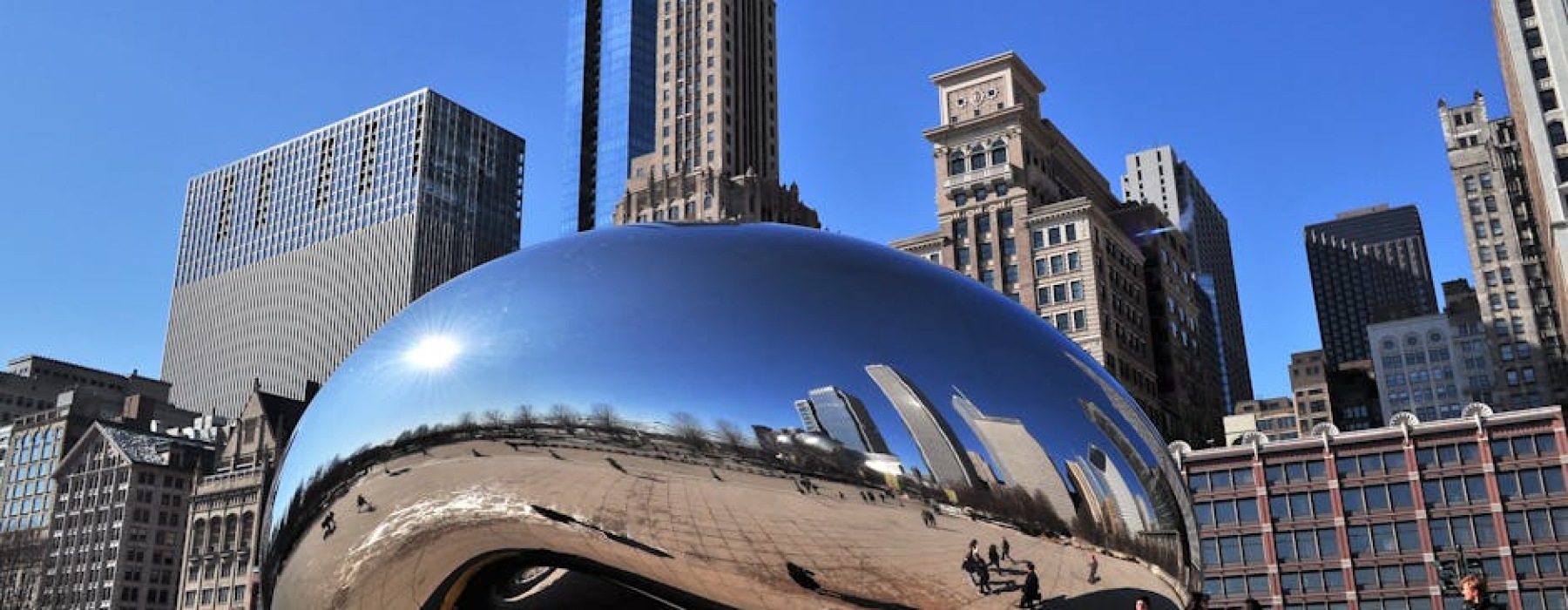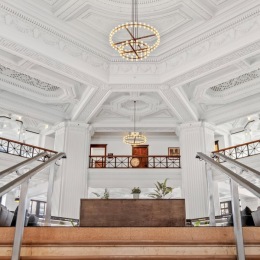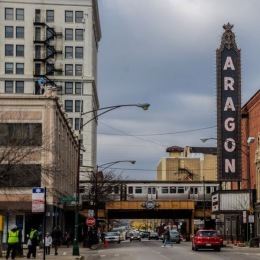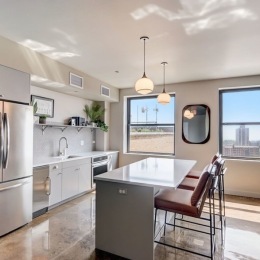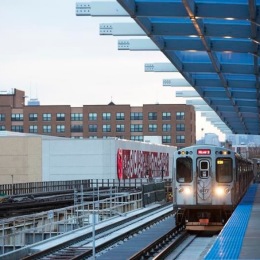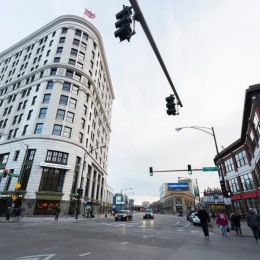Chicago's Cultural Mosaic: An Unforgettable Journey
Chicago cultural attractions offer an extraordinary blend of world-class museums, historic architecture, vibrant performing arts, and diverse neighborhood experiences. For visitors seeking cultural immersion, here are the top attractions you shouldn't miss:
- Chicago Cultural Center - Home to the world's largest Tiffany stained glass dome and over 700 free programs annually
- Art Institute of Chicago - Houses nearly 300,000 artworks spanning 5,000 years
- Field Museum - Features over 40 million specimens including SUE, the most complete T-Rex fossil
- Museum of Science and Industry - Spans 400,000 square feet with 35+ permanent exhibits
- Shedd Aquarium - Home to 32,000 animals from diverse aquatic habitats
- National Museum of Mexican Art - Always free admission with rotating exhibitions
- Chicago Architecture Center - Gateway to understanding the city's architectural legacy
Chicago stands as a global cultural powerhouse, where historic landmarks and cutting-edge artistic expressions coexist in perfect harmony. The city's cultural scene spans ancient Egyptian artifacts at the Field Museum to contemporary art installations at the Museum of Contemporary Art.
What makes Chicago truly special is how accessible these cultural treasures are. The Chicago Cultural Center presents more than 700 humanities programs each year, many completely free and open to the public. This commitment to accessibility extends throughout the city, with numerous free museum days and public art displays available year-round.
Beyond the major institutions, Chicago's neighborhoods offer authentic cultural experiences through community museums, street art, ethnic festivals, and historic theaters. From Pilsen's vibrant murals to the historic theaters of Uptown, each area contributes unique threads to the city's cultural mix.
Whether you're exploring the magnificent Tiffany dome at the Chicago Cultural Center or catching a free summer concert at Millennium Park, Chicago's cultural attractions provide endless opportunities for findy and inspiration throughout the year.
Chicago Cultural Attractions: Why the Windy City is a Global Culture Capital
Chicago earns its spot among the world's cultural giants not by accident, but through an incredible mix of museums, theaters, architectural wonders, and neighborhood art scenes that tell the story of America itself. There's something magical about how the city blends old-world tradition with bold innovation, creating spaces where history and cutting-edge creativity live side by side.
The magnificent Chicago Cultural Center stands as the crown jewel of chicago cultural attractions, affectionately known as "The People's Palace." Step inside this Beaux-Arts masterpiece and look up—you'll be standing beneath the world's largest Tiffany stained glass dome, a breathtaking mosaic of roughly 30,000 individual glass pieces. The best part? This stunning landmark welcomes everyone with completely free admission and hosts hundreds of programs each year, from art exhibitions to concerts and family events.
Just a short walk away, the Art Institute of Chicago houses nearly 300,000 works spanning human creativity across millennia. Here you can stand face-to-face with iconic American masterpieces like Grant Wood's "American Gothic" and Edward Hopper's "Nighthawks," plus an Impressionist collection that rivals any in Europe. As one visitor recently shared: "I spent almost six hours here and still didn't see everything. Buying tickets online saved at least 30 minutes in line."
Nature and science buffs will find their happy place at the Field Museum, home to over 40 million specimens and artifacts. Don't miss saying hello to SUE, the most complete T-Rex skeleton ever finded, who stands guard in the main hall. Nearby, the Museum of Science and Industry will blow your mind with 400,000 square feet of hands-on exhibits, including a captured German U-505 submarine and an incredibly detailed model railroad that will make you feel like a giant.
For underwater trips without getting wet, Shedd Aquarium introduces you to 32,000 creatures from oceans, rivers, and lakes worldwide. The National Museum of Mexican Art in Pilsen offers always-free admission to its outstanding collection, while the DuSable Black History Museum preserves the experiences of people of African descent through more than 15,000 artifacts.
Navy Pier combines fun, food, and culture along Lake Michigan's shoreline, while Millennium Park showcases public art installations including the beloved Cloud Gate sculpture—better known by locals and visitors alike as "The Bean."
The Heart of "Chicago Cultural Attractions" in the Loop
The Loop forms the beating heart of chicago cultural attractions, packing an incredible number of world-class institutions into a walkable downtown area. This cultural density is what makes Chicago truly special—you can literally spend days exploring one amazing site after another without needing to venture far.
Grant Park, Chicago's gorgeous front yard, stretches across 319 acres along the eastern edge of the Loop. This green oasis hosts major cultural events throughout the year and showcases Buckingham Fountain, one of the world's largest fountains, with spectacular water displays choreographed to music and lights.
What makes exploring the Loop's cultural treasures so easy is its fantastic transportation network. The Chicago Transit Authority (CTA) serves the area beautifully, with multiple train lines converging at liftd and subway stations. Hundreds of thousands of visitors steer these attractions annually, helped by clear signage and frequent service.
Walking between museums and theaters is a delight thanks to thoughtful urban design. Wide sidewalks, well-marked pedestrian crossings, and the scenic Chicago Riverwalk connect cultural destinations safely and beautifully. It's no wonder the area consistently ranks among America's most walkable urban centers.
Living at The Teller House puts you just a quick train ride away from this cultural wonderland, with the Red Line whisking you directly to the Loop in under 30 minutes. After a day immersed in art and history, you can return to the comfort of your apartment in Uptown, where more amenities and local cultural gems await.
Neighborhood Gems Expanding the "Chicago Cultural Attractions" Landscape
While downtown houses Chicago's flagship cultural institutions, chicago cultural attractions stretch far beyond the Loop into diverse neighborhoods that showcase the city's multicultural soul and grassroots creativity.
Pilsen, on the Lower West Side, has transformed into one of Chicago's most vibrant arts districts. Walking these streets feels like exploring an open-air gallery, with stunning murals depicting Mexican heritage and social themes adorning buildings at every turn. The National Museum of Mexican Art anchors the neighborhood's cultural identity, presenting exhibitions that connect ancient civilizations to today's Latino artists.
Chinatown invites you into a world of traditional architecture, authentic cuisine, and cultural celebrations. The neighborhood's Chinatown Museum and cultural plaza host performances year-round, with the Lunar New Year parade bringing spectacular color and energy to winter streets.
Bronzeville, historically known as Chicago's "Black Metropolis," celebrates African American heritage through meaningful landmarks like the Monument to the Great Northern Migration and the Bronzeville Walk of Fame. Walking these streets, you're tracing the footsteps of influential figures like poet Gwendolyn Brooks, jazz legend Louis Armstrong, and civil rights pioneer Ida B. Wells.
In Uptown, where The Teller House makes its home, historic theaters form the backbone of a thriving entertainment district. The neighborhood's legacy as an entertainment hub dates back to the Roaring Twenties and continues today with iconic venues like the Riviera Theatre, Aragon Ballroom, and the Green Mill Jazz Club—a former speakeasy once frequented by Al Capone himself.
Local festivals throughout Chicago's neighborhoods offer authentic cultural experiences that tourists often miss. From the Puerto Rican Festival in Humboldt Park to Chinese New Year celebrations in Chinatown, these events bring communities together through traditions, food, music, and art.
Community museums and cultural centers provide intimate glimpses into specific aspects of Chicago's heritage. The Swedish American Museum in Andersonville, the Ukrainian Institute of Modern Art in Ukrainian Village, and the Chinese-American Museum of Chicago all tell important stories about the immigrant communities that shaped the city.
Living at The Teller House puts you at the crossroads of these neighborhood explorations, with excellent public transportation connecting you to communities throughout the city. Our neighborhood offers its own rich cultural landscape while providing easy access to Chicago's broader cultural mix.
Must-See Museums & Cultural Centers
Chicago's museum campus stands as one of the world's most impressive cultural hubs, where institutions of global significance sit side by side, each a leader in its field.

The Art Institute of Chicago welcomes you with its iconic lion statues before revealing treasures spanning 5,000 years of human creativity. Wander through the Impressionist gallery housing one of the largest collections outside Paris, where Monet's water lilies and Renoir's sun-dappled scenes transport you to another era. The airy Renzo Piano-designed Modern Wing adds 264,000 square feet of exhibition space bathed in natural light. As one visitor recently shared, "The open-access model with no paywalls behind famous works stands out as visitor-friendly."
Just a short walk away, the Field Museum houses an astonishing 40 million cataloged items. While only a fraction are on display at any time, what's available will leave you speechless. Beyond SUE the T-Rex (the most complete T-Rex skeleton ever finded), you'll come face-to-face with the infamous "man-eaters of Tsavo" lions, step into carefully recreated Ancient Egyptian tombs filled with original artifacts, and marvel at one of North America's richest meteorite collections.
The Museum of Science and Industry breathes new life into the former Palace of Fine Arts from the 1893 World's Columbian Exposition. Throughout its vast 400,000 square feet, hands-on exhibits invite you to touch, explore, and experiment. Climb aboard the captured German U-505 submarine (the only one captured by the U.S. Navy during World War II), descend into a recreated coal mine, or watch model trains steer through a miniature America across 3,500 square feet of intricate landscapes.
For those drawn to contemporary creativity, the Museum of Contemporary Art Chicago showcases works created since 1945, regularly refreshing exhibitions to highlight emerging artists and new media. Its thought-provoking video installations reward those willing to engage deeply. One family recently finded: "We explored the video rooms and enjoyed an impromptu scavenger hunt with our child that the museum provided with our map."
The magnificent Chicago Cultural Center deserves special mention as the city's cultural living room. This architectural gem hosts more than 700 free programs annually—concerts, dance performances, theater productions, film screenings, lectures, and family events. Look up in Preston Bradley Hall to see the world's largest Tiffany stained glass dome, a 38-foot marvel containing approximately 30,000 pieces of glass catching the sunlight in kaleidoscopic patterns.
In Pilsen, the National Museum of Mexican Art stands as the largest Latino cultural institution in the United States and warmly welcomes visitors with always-free admission. Its 10,000-piece collection spans 3,000 years of Mexican artistic expression. As their mission proudly states, "We represent the Mexican community from our own point of view and our own voice."
The DuSable Black History Museum and Education Center, the nation's oldest independent African American museum, preserves over 15,000 treasures including paintings, sculptures, print works, and historical memorabilia. During Black History Month, extended hours accommodate the increased interest in this vital cultural institution.
Families with young explorers will love the Chicago Children's Museum at Navy Pier, where three floors of interactive exhibits encourage learning through play. During "Spring Weeks of Play," special activities focus on creative expression and skill development in a joyful environment.
All these chicago cultural attractions are easily accessible via CTA trains and buses. The CTA trip planner helps you map efficient routes between cultural destinations, making museum-hopping a breeze.
Highlights & Insider Tips for Each Major Venue
Make the most of your cultural trips with these local insights for each major venue:
At the Art Institute, start your day with the often-overlooked Thorne Miniature Rooms—68 exquisitely crafted room boxes depicting European and American interiors from the 13th century through the 1930s. Each tiny masterpiece captures a moment in time with astonishing detail. Visit on weekdays or non-free days for a more intimate experience, and purchase tickets online to bypass entry lines. Once inside, you'll appreciate the museum's visitor-friendly approach with no additional paywalls for special exhibitions.
For the Field Museum, head straight to SUE the T-Rex when doors open, then journey through 4 billion years of life on Earth in the comprehensive Evolving Planet exhibit. Don't miss the Inside Ancient Egypt exhibit featuring a walk-through mastaba (tomb) with original hieroglyphs and mummies. The quietest visiting times are typically weekday mornings when school groups are less present.
At the Museum of Science and Industry, splurge on the U-505 Submarine special tour for behind-the-scenes access. The dramatic "Science Storms" exhibit brings natural phenomena to life through enormous interactive displays, including a 40-foot tornado you can control and a 20-foot tsunami tank demonstrating wave physics. The museum tends to quiet down in late afternoon after school groups depart.
The Chicago Cultural Center offers wonderful free guided tours that depart from the first-floor welcome center with no reservation required. Beyond the stunning Tiffany dome in Preston Bradley Hall, be sure to visit the Grand Army of the Republic Rotunda with its own impressive stained glass. Check the center's online calendar for free concerts, which often feature local musicians performing beneath the Tiffany dome with remarkably clear acoustics.
At the Museum of Contemporary Art, Tuesday evenings offer free admission for Illinois residents. During summer months, the museum's Tuesdays on the Terrace music series celebrates Chicago's rich jazz tradition in a beautiful outdoor setting. Before leaving, browse the Buddy shop where 100% of sales directly support local artists.
Many museums reward members with exclusive early access hours (typically the first hour of the day), providing a peaceful experience for those willing to invest in membership. The Art Institute, Field Museum, and Shedd Aquarium all offer this meaningful perk to their members.
Visitors with sensory sensitivities will appreciate specialized programs at several institutions. The Field Museum and Shedd Aquarium provide sensory-friendly app guides and designated quiet spaces. The Art Institute offers touch tours for visitors with vision impairments, while the Chicago Cultural Center provides audio description services with 72 hours' advance notice.
Free & Low-Cost Cultural Stops
Chicago generously offers an abundance of free and low-cost cultural experiences that rival its ticketed attractions. Beyond the always-free Chicago Cultural Center, several outstanding institutions welcome visitors without charging admission.
Lincoln Park Zoo, one of North America's oldest zoos, offers free admission every day of the year. Stroll through 35 acres where nearly 200 species thrive in naturalistic habitats, then continue to the adjacent Lincoln Park Conservatory to find exotic plants displayed in four stunning glass houses.
The breathtaking Garfield Park Conservatory, often described as "landscape art under glass," spans 4.5 acres and houses thousands of plant species across eight indoor display gardens. This 1906 architectural gem designed by Jens Jensen welcomes visitors free of charge (with suggested donations appreciated).
Both the National Museum of Mexican Art in vibrant Pilsen and the DuSable Black History Museum in historic Washington Park maintain free admission policies to ensure everyone can access these cultural treasures. The Smart Museum of Art at the University of Chicago and the fascinating Oriental Institute (showcasing ancient Near Eastern civilizations) also offer free entry.
Chicago's public libraries frequently host cultural exhibitions and events at no cost. The downtown Harold Washington Library Center features rotating art exhibitions, engaging author talks, and diverse cultural programs throughout the year.
Neighborhood street art creates free open-air galleries across the city. Pilsen's 16th Street murals stretch for several colorful blocks, showcasing works by local and international artists. The Wabash Arts Corridor in the South Loop features massive murals changing building facades into breathtaking public art.
For those planning to visit multiple major attractions, the Chicago CityPASS offers significant savings. Current CityPASS holders report saving at least 30% on combined admission to five attractions, including the Field Museum, Shedd Aquarium, and Art Institute.
Many museums offer designated free admission days for Illinois residents throughout the year. While these days attract crowds, they provide no-cost access to world-class institutions. The Field Museum, Art Institute, and Adler Planetarium all participate in this community-minded program.
Living at The Teller House puts you in an ideal position to enjoy these chicago cultural attractions, with convenient transit options connecting you to both downtown institutions and neighborhood gems. After a day of museum exploration, you'll appreciate returning to your comfortable apartment in Uptown, itself a neighborhood rich in cultural history.
Iconic Architecture & Public Art Walking Tour
Chicago's architectural heritage stands as one of its most distinctive cultural assets. The city that gave birth to the skyscraper continues to showcase architectural innovation alongside preserved historic structures.

The Chicago Architecture Center serves as the perfect starting point for exploring the city's built environment. Here, fascinating exhibits bring the story of Chicago's architectural evolution to life—from the dramatic rebuilding after the Great Fire of 1871 to the soaring contemporary towers that define today's skyline. The center's incredibly detailed models help visitors grasp the scale and significance of key buildings that have shaped the city.
When you board the center's river cruise (voted best tour in the U.S. by USA Today readers), you'll experience Chicago's architectural masterpieces from a completely unique vantage point. As one delighted cruise participant shared, "Seeing about 40 significant buildings from the water gives you a completely different perspective on the city's development." The gentle glide along the river reveals facades and details often missed from street level.
For those craving breathtaking views, Willis Tower's Skydeck (formerly Sears Tower) and 360 CHICAGO at the John Hancock Center offer unforgettable panoramas. The brave-hearted won't want to miss 360 CHICAGO's TILT feature—an enclosed moving platform that literally tilts visitors out over Michigan Avenue from the 94th floor. It's an architectural experience that combines innovation with a heart-racing thrill!
In Hyde Park, Frank Lloyd Wright's Frederick C. Robie House stands as a masterpiece of Prairie School design. Wright's approach—with its horizontal lines, overhanging eaves, and seamless integration with the landscape—forever changed how we think about residential architecture. Step inside during a guided tour and find Wright's obsessive attention to detail, from custom-designed furniture to ingeniously placed light fixtures.
The massive Merchandise Mart exemplifies Chicago's ambitious commercial architecture. Once the largest building in the world with a staggering 4 million square feet of floor space, this Art Deco giant now houses design showrooms, tech companies, and retail spaces. Its sheer scale and ornate façade make it a must-see on any architectural tour.
Throughout Chicago, public art transforms the urban landscape into an open-air museum. Chicago cultural attractions include Millennium Park's Cloud Gate (affectionately known as "The Bean"), which has become the city's most photographed artwork. Anish Kapoor's highly polished stainless steel creation reflects both the skyline and visitors, creating endless compositions that change with the weather, time of day, and the people surrounding it.
Nearby, Buckingham Fountain in Grant Park puts on a spectacular show. One of the world's largest fountains, it symbolizes Lake Michigan surrounded by four states. On summer evenings, its magnificent water displays reach heights of 150 feet, choreographed to music and improved by colorful lights—a perfect example of how Chicago combines art, architecture, and public space.
The city's historic skyscrapers tell fascinating stories of architectural innovation. The Chicago Board of Trade Building's striking Art Deco design culminates in a statue of Ceres, the Roman goddess of agriculture, while the gleaming white terra cotta facade of the Wrigley Building glows magnificently when illuminated at night.
Each October, Open House Chicago offers a rare opportunity to peek behind normally closed doors at more than 250 sites across the city. This popular Chicago Architecture Center program lets curious visitors explore architectural treasures in neighborhoods throughout Chicago, from hidden gems to celebrated landmarks.
For a deeper understanding of Chicago's architectural heritage and to plan your own architectural trip, visit the Chicago Architecture Center website to explore tour options, exhibitions, and educational resources.
Architectural Landmarks That Double as Cultural Spaces
Many of Chicago's architectural masterpieces serve dual purposes as both visual landmarks and vibrant cultural venues, creating spaces where design and artistic expression converge.
The Rookery, designed by Burnham and Root in 1888, welcomes visitors to explore its magnificent lobby where magic happens daily. Step inside and you'll find yourself in a stunning light court redesigned by Frank Lloyd Wright in 1905. The interplay of natural light, marble, and ornamental ironwork creates a space that feels both historic and timeless, even as the building continues its life as a working office building.
When you attend a performance at the Auditorium Theatre, completed in 1889, you're experiencing the collaborative genius of Dankmar Adler and Louis Sullivan. This acoustic marvel hosts the Joffrey Ballet, Broadway shows, and concerts within its beautifully restored interior. The theater's perfect sightlines and innovative (for its time) air conditioning system show how thoughtful architectural design improves cultural experiences for everyone.
The Chicago Board of Trade Building isn't just an Art Deco masterpiece defining the southern end of LaSalle Street with its dramatic stepped silhouette—it's also home to a trading floor where financial culture has evolved over decades. Public tours reveal both the building's architectural splendor and its fascinating role in global commerce.
At the Chicago Cultural Center, Preston Bradley Hall's spectacular 38-foot Tiffany dome creates an incomparable setting for free cultural programs. The light filtering through thousands of pieces of stained glass transforms ordinary events into extraordinary experiences. Just down the hall, the Grand Army of the Republic (G.A.R.) Rotunda and Memorial Hall, originally designed to honor Civil War veterans, now host exhibitions and performances. Architecture buffs will appreciate the central staircase on Randolph Street with its unusually gentle incline—specifically designed to accommodate aging Civil War veterans ascending to memorial rooms.
The Garfield Park Conservatory beautifully blends architectural innovation with horticultural displays. Jens Jensen's "landscape art under glass" design creates distinct environments for different plant communities while maintaining a cohesive architectural vision. Throughout the year, the conservatory hosts art installations, music performances, and cultural events that take advantage of its unique spaces.
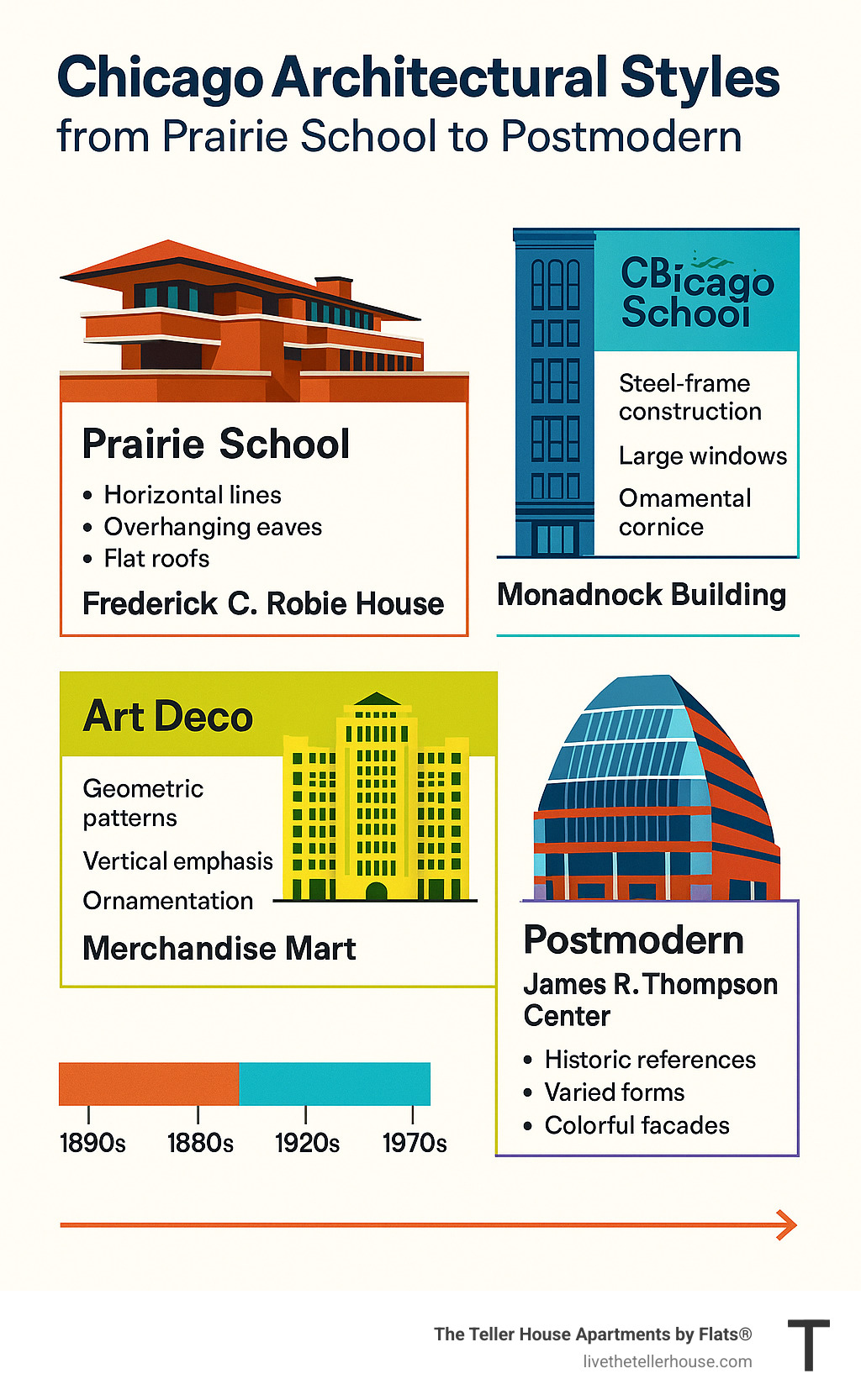
These dual-purpose landmarks demonstrate how Chicago's architectural heritage lifts its cultural offerings. The thoughtful design of these spaces creates environments where art, performance, and community engagement flourish within historically significant structures, making a visit to any of these buildings a rich, multidimensional experience.
Music, Theater & Performing Arts Scene
Chicago's performing arts scene pulses with energy that rivals any in the world, offering a distinctive character shaped by the city's diverse communities and innovative spirit. From soaring symphonies to groundbreaking theater and legendary comedy, the city welcomes cultural explorers of all tastes.
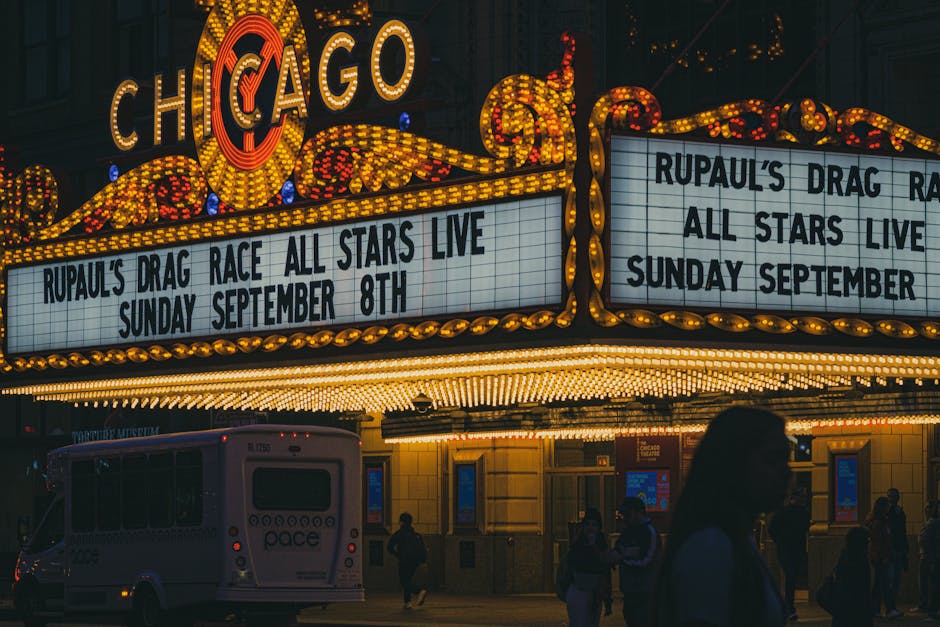
Founded in 1891, the Chicago Symphony Orchestra stands tall among the world's finest orchestras. When you step into Symphony Center on Michigan Avenue, you're entering a space where exceptional acoustics bring both classical masterworks and contemporary compositions to vibrant life. Under Music Director Riccardo Muti, the CSO continues its legacy of musical excellence that has captivated audiences for generations.
Just down the street, the magnificent Art Deco Lyric Opera House welcomes nearly 3,600 guests to experience the grandeur of the Lyric Opera of Chicago. Each season unfolds with classic and contemporary operas performed by international stars, supported by the talented Lyric Opera Orchestra and Chorus. Their "Lyric Unlimited" program takes opera beyond the stage, weaving musical storytelling into communities throughout the city.
Chicago's theater scene thrives with more than 200 companies ranging from Tony Award-winning regional theaters to intimate storefront ensembles creating boundary-pushing work. The Goodman Theatre, Chicago's oldest and largest nonprofit theater, balances timeless classics with bold world premieres on its two stages. As one theater critic beautifully put it, "The Goodman consistently balances artistic ambition with productions that speak to Chicago's diverse communities."
Over at Navy Pier, Chicago Shakespeare Theater breathes fresh life into the Bard's works alongside thought-provoking contemporary plays in their versatile theater space. Their WorldStage Series brings theatrical treasures from around the globe to Chicago, creating cultural exchanges that enrich our city's artistic landscape.
Comedy lovers flock to The Second City, the legendary proving ground where Bill Murray, Tina Fey, and Stephen Colbert (among many others) honed their craft. Their shows blend carefully crafted scenes with spontaneous improvisation, often incorporating audience suggestions and riffing on current events with their trademark wit.
Chicago's jazz heritage continues to thrive at venues like the Green Mill in Uptown, just a short walk from The Teller House. This historic club, once frequented by Al Capone himself, serves up traditional and contemporary jazz in an authentic speakeasy atmosphere that transports you to another era. Each summer, the Chicago Jazz Festival transforms Millennium Park into a celebration of this quintessentially American art form with free performances that draw jazz lovers from across the globe.
The city's blues tradition finds its home in beloved clubs like Kingston Mines and Buddy Guy's Legends, where the electric Chicago blues style that shaped rock and roll lives on. When summer arrives, the Chicago Blues Festival – the largest free blues festival in the world – turns Grant Park into a vibrant celebration of this powerful musical tradition.
Throughout the year, major festivals showcase Chicago's cultural vitality. Lollapalooza brings hundreds of thousands of music fans to Grant Park for four days of performances spanning countless genres. The Chicago Gospel Music Festival celebrates the city's pivotal role in developing this soul-stirring tradition. Meanwhile, the World Music Festival presents artists from across the globe in venues throughout the city, all completely free to enjoy.
Families find plenty to love at Chicago Children's Theatre, where productions engage young imaginations with age-appropriate themes and interactive elements. The annual Chicago International Puppet Theater Festival reveals the sophisticated artistry of puppetry that captivates audiences of all ages.
Experiencing "Chicago Cultural Attractions" After Dark
When the sun sets, Chicago cultural attractions transform to reveal different facets of the city's vibrant cultural landscape.
Live music venues across Chicago come alive after dark, from the iconic Chicago Theatre with its brilliantly illuminated marquee to intimate spaces like Schubas Tavern and the Empty Bottle where you might catch tomorrow's breakout artist in a crowd of just a few hundred fellow music lovers.
Summer evenings at the Museum of Contemporary Art bring the beloved Tuesdays on the Terrace series, now celebrating 25 years of combining exceptional jazz performances with stunning Lake Michigan views. This free program showcases Chicago's finest jazz musicians performing on the museum's outdoor terrace as the sky turns golden. Grabbing a fast pass is recommended for popular performances, as these magical evenings tend to fill quickly.
Twice weekly during summer months, Navy Pier fireworks paint the night sky with bursts of color choreographed to music over Lake Michigan. This free spectacle draws crowds to the pier and surrounding parks, creating a shared moment of wonder against the backdrop of Chicago's glittering skyline.
For cultural experiences with a view, Chicago's rooftop lounges offer breathtaking panoramas of the city's architectural marvels. Many feature retractable roofs and cozy fire pits for year-round comfort. The I|O Godfrey Roofscape spans a generous 15,000 square feet of indoor/outdoor space, while VU Rooftop perches 22 stories above the busy streets below.
Chicago's historic theaters take on an almost magical quality after dark, their ornate interiors and glowing marquees setting the stage before performances even begin. The Oriental Theatre (now James M. Nederlander Theatre), Chicago Theatre, and Auditorium Theatre all offer evening tours that open up the secrets of their architectural and cultural significance.
Art lovers find evening inspiration in River North and West Loop galleries, which regularly host openings where you can explore contemporary art while chatting with artists and collectors. These events typically include refreshments and sometimes feature enlightening artist talks or performances that deepen your appreciation of the work.
The Chicago Cultural Center's evening concerts, film screenings, and lectures create unforgettable experiences throughout the year. Imagine listening to chamber music beneath the magnificent Tiffany dome as evening light filters through the stained glass – it's the kind of cultural memory that stays with you.
Living at The Teller House puts you within an easy stroll of Uptown's vibrant nightlife and entertainment venues, including the historic Aragon Ballroom, Riviera Theatre, and Green Mill Jazz Club. After enjoying downtown Chicago cultural attractions, you can continue your evening in the neighborhood or return to the comfort of home. Be sure to check our blog for upcoming neighborhood events and cultural happenings.
Accessible & Family-Friendly Performing Venues
Chicago accepts cultural inclusion, ensuring that performing arts venues welcome visitors of all abilities and ages with open arms.
Many major venues regularly schedule American Sign Language (ASL) interpretation for select performances. The Goodman Theatre, Chicago Shakespeare Theater, and Steppenwolf Theatre Company all make this service available throughout their seasons. The Chicago Cultural Center goes a step further, offering ASL interpretation with just 72 hours' advance notice for most of their events.
Families with members who have sensory processing differences appreciate Chicago's growing number of sensory-friendly performances. These thoughtfully designed shows feature adjusted sound levels, house lights kept partially on, and designated quiet areas for those who need a break. Chicago Children's Theatre has been a local pioneer in creating these accommodations and continues to offer regular sensory-friendly performances that welcome everyone.
Physical accessibility has improved dramatically across Chicago's cultural landscape. Historic theaters like the majestic Auditorium Theatre have been carefully retrofitted with elevators and accessible seating areas, while newer venues incorporate universal design principles from the ground up. Most venues offer well-positioned wheelchair seating with companion seats nearby.
Young families find welcoming environments at family-friendly performing venues throughout the city. The Chicago Children's Theatre provides practical amenities like stroller parking and family restrooms, along with performances designed for specific age ranges. Lookingglass Theatre Company creates imaginative productions that appeal across generations, often adapting classic stories with visual storytelling techniques that captivate both children and adults.
Students on tight budgets can still enjoy Chicago's cultural riches thanks to widespread discount programs. Most major theaters, the Chicago Symphony Orchestra, and the Lyric Opera offer significantly reduced ticket prices for students with valid ID. Some venues also offer last-minute rush tickets shortly before performances, providing spontaneous cultural experiences at bargain prices.
Getting to these cultural gems is easy thanks to Chicago's comprehensive transportation network. Many performance venues sit near CTA train stations and bus stops, making car-free cultural outings simple. Divvy bike stations near cultural venues provide another flexible transportation option, with stations conveniently located at Navy Pier, Millennium Park, and throughout the theater district.
Visitors with vision impairments can fully experience theatrical performances through audio description services. Trained describers provide spoken commentary about visual elements during natural pauses in dialogue, painting a verbal picture of staging, costumes, and action. The Goodman Theatre, Chicago Shakespeare Theater, and Victory Gardens Theater regularly offer this thoughtful service that makes theater accessible to everyone.
Planning Your Cultural Itinerary & Getting Around
Planning your journey through Chicago cultural attractions doesn't have to be overwhelming. With a little preparation, you can create a seamless experience that maximizes your cultural immersion while minimizing travel stress.

Chicago's public transportation system makes cultural exploration a breeze. The Chicago Transit Authority (CTA) connects virtually all major attractions through its network of colorful train lines and comprehensive bus routes. The iconic "L" trains – so named because much of the system runs on liftd tracks – create a distinctive part of Chicago's urban landscape while efficiently moving you between neighborhoods. For night owls, the Red and Blue Lines never sleep, operating 24/7 to accommodate late-night theater exits or early morning museum visits.
When venturing beyond the city center, Metra commuter rail offers a comfortable alternative. With 11 lines and 239 stations spreading like spokes from downtown, Metra opens up cultural opportunities throughout the metropolitan area. Their weekend passes are particularly budget-friendly, offering unlimited Saturday and Sunday rides for one flat fee – perfect for cultural triprs.
For those who prefer exploring on two wheels, Divvy bike-sharing stands ready with over 600 stations dotted across Chicago. You'll find Divvy stations conveniently positioned near most major cultural institutions, including right outside the Chicago Cultural Center on Michigan Avenue. The city continues expanding its network of protected bike lanes, making cycling an increasingly pleasant option for moving between attractions, especially along the lakefront.
"I was amazed at how easy it was to bike between the Art Institute and Field Museum," shares one recent visitor. "The dedicated paths along Grant Park made it feel safe even though I'm not usually a city cyclist."
Driving to cultural destinations? Several Millennium Garages offer underground parking near major downtown attractions. Pro tip: booking your parking online ahead of time typically saves significantly compared to drive-up rates. Many cultural venues also partner with parking apps for discounted rates.
Don't overlook the Chicago Riverwalk as both a cultural destination and transportation corridor. This 1.25-mile pedestrian path connects numerous attractions along the Chicago River, offering not just spectacular architectural views but also public art installations, performance spaces, and river tour boarding points. It's a delightful way to move between cultural stops while enjoying fresh air and river breezes.
Accessibility remains a priority throughout Chicago's transportation network. Most CTA train stations feature elevators, all buses are equipped with ramps, and paratransit options ensure everyone can access the city's cultural riches. The Chicago Cultural Center exemplifies this commitment, inviting visitors to "email dcase@cityofchicago.org at least 72 hours in advance to request ASL interpretation or audio description."
For visitors planning to hit multiple major attractions, the Chicago CityPASS offers substantial savings. Current packages include admission to five top destinations including the Field Museum, Shedd Aquarium, and your choice between the Art Institute and 360 CHICAGO Observation Deck, with savings of around 30% compared to purchasing individual tickets.
Navigating public transit becomes simpler with a Ventra card – your reusable pass for CTA trains and buses. Options range from pay-as-you-go to unlimited ride passes ideal for cultural exploration. Visit www.ventrachicago.com for current fare information and to purchase cards online before your arrival.
Sample 3-Day "Culture-Packed" Itinerary
Want to experience Chicago's cultural treasures efficiently? This three-day itinerary balances major institutions with neighborhood gems:
Day 1: Loop Museums Start your morning at the magnificent Chicago Cultural Center, where the world's largest Tiffany dome creates an unforgettable welcome. The free Welcome Center provides orientation materials and tour information to help shape your cultural journey. After absorbing the building's architectural splendor, walk a few blocks to the Art Institute of Chicago. Rather than attempting to see everything, focus on the museum's highlights – the extraordinary Impressionist galleries, iconic American works like "American Gothic," and the Modern Wing's light-filled galleries.
When hunger strikes, treat yourself to authentic Chicago-style deep-dish pizza at a nearby restaurant. The hearty meal will fuel your afternoon exploration of Millennium Park, where Cloud Gate (affectionately known as "The Bean") reflects both skyline and visitors in its gleaming surface. Don't miss Crown Fountain's interactive water features and the serene Lurie Garden, which showcases native Midwestern plantings.
As evening approaches, lift your cultural experience with a performance at the Chicago Theatre, whose illuminated marquee has become a city icon, or lose yourself in the Chicago Symphony Orchestra's world-class musicianship.
Day 2: Architecture & Navy Pier Begin your second day aboard a Chicago Architecture Center river cruise, where expert docents reveal the stories behind the skyline. These 90-minute tours consistently rank among Chicago's top experiences, providing context that improves your entire visit. Afterwards, deepen your architectural understanding at the Chicago Architecture Center itself, whose detailed models and interactive exhibits explain how Chicago transformed architecture worldwide.
For lunch, accept local tradition with a Chicago-style hot dog – just remember the cardinal rule: absolutely no ketchup! In the afternoon, head to Navy Pier for a mix of cultural and recreational experiences. The Chicago Children's Museum offers engaging exhibits for young visitors, while Chicago Shakespeare Theater presents world-class productions in an intimate setting. The Crystal Gardens provide a lush indoor respite regardless of weather.
Cap your evening with seasonal Navy Pier fireworks or, if you prefer a more sophisticated experience, visit one of Chicago's stunning rooftop lounges for skyline views paired with creative cocktails.
Day 3: Neighborhood Art Walks Venture beyond downtown on your final day to explore Chicago's neighborhood cultural gems. Begin in Pilsen at the National Museum of Mexican Art, whose vibrant collections celebrate Mexican heritage and contemporary Latino artists. Afterwards, wander the neighborhood streets to find colorful murals that transform buildings into stunning public canvases.
Lunch in Pilsen offers the perfect opportunity to sample authentic Mexican cuisine from family-owned restaurants. In the afternoon, hop on the Red Line to Uptown – home to The Teller House – to find historic entertainment venues that have hosted performers from Charlie Chaplin to Chance the Rapper. The legendary Green Mill Jazz Club, once a favorite haunt of Al Capone, offers weekend afternoon sessions in an authentic speakeasy atmosphere.
Complete your cultural journey with an evening performance at one of Uptown's historic theaters or savor dinner at a neighborhood restaurant showcasing Chicago's global culinary influences.
Throughout your cultural expedition, don't miss Chicago's diverse food scene. Beyond the famous deep-dish and hot dogs, each neighborhood offers distinctive flavors – from dim sum in Chinatown to tandoori specialties along Devon Avenue. Walking food tours provide delicious education on how culinary traditions connect to neighborhood histories.
Annual Events & Festivals to Plan Around
Chicago's cultural calendar bursts with festivals and events throughout the year that showcase the city's artistic diversity. Time your visit to coincide with these celebrations for an improved cultural experience.
The World Music Festival transforms venues citywide each September into global stages where artists from across continents share their musical traditions. What makes this festival special isn't just the international lineup but that every performance is completely free, creating an accessible celebration of cross-cultural connection through music.
Food enthusiasts should mark their calendars for Chicago Gourmet in September, when Millennium Park becomes a culinary playground featuring celebrity chefs, cooking demonstrations, and tastings that highlight Chicago's position as a world-class dining destination. The event showcases both established culinary stars and emerging talent reshaping the food landscape.
As winter approaches, Christkindlmarket brings German holiday traditions to Daley Plaza from late November through Christmas. This charming open-air market recreates the magic of Nuremberg's famous Christmas market with handcrafted ornaments, traditional foods, and warming Glühwein served in collectible mugs. The market's twinkling lights and festive atmosphere have become a cherished Chicago tradition.
Architecture buffs won't want to miss Open House Chicago in October. This free weekend event, organized by the Chicago Architecture Center, open ups the doors to over 250 significant buildings not typically open to the public. From historic skyscrapers to repurposed industrial spaces, this behind-the-scenes access reveals Chicago's architectural evolution across diverse neighborhoods.
Winter's chill brings Light Up the Lake to Navy Pier, changing the space with an indoor light garden featuring massive illuminated sculptures, a skating rink, and seasonal activities. The weather-protected setting makes this a reliable family-friendly option during Chicago's colder months.
Throughout the year, neighborhood festivals celebrate Chicago's diverse communities. The vibrant Puerto Rican Festival in Humboldt Park, colorful Chinese New Year celebrations in Chinatown, and the spirited South Side Irish Parade all showcase cultural traditions through music, dance, food, and community gatherings. These authentic celebrations often provide more meaningful cultural insights than many ticketed attractions.
Music lovers should plan around the Chicago Blues Festival in June and Chicago Jazz Festival in September, both presenting free performances in Millennium Park. These events honor Chicago's pivotal role in developing these distinctly American musical forms, bringing together legendary performers and emerging artists on stages accessible to all.
For those fascinated by technology and innovation, the Robot Block Party at the Museum of Science and Industry offers a glimpse into the future through interactive demonstrations showcasing cutting-edge robotics. This family-friendly event bridges entertainment and education in true Chicago style.
Living at The Teller House puts you at the crossroads of Chicago's cultural landscape, with direct transit connections to downtown institutions while surrounded by Uptown's own rich entertainment heritage. Whether you're exploring world-class museums or finding neighborhood cultural gems, you'll find Chicago's cultural attractions create unforgettable experiences in every season.
Frequently Asked Questions about Chicago Culture
What are the best family-friendly cultural attractions?
Chicago truly shines when it comes to cultural experiences the whole family can enjoy. The Museum of Science and Industry consistently tops family favorites lists with its wonderfully interactive exhibits that turn science into trip. "My kids spent hours in the Science Storms exhibit, creating tornados and triggering avalanches," one delighted parent shared after their visit. The museum's hands-on approach makes complex concepts accessible even to the youngest visitors.
Navy Pier houses the fantastic Chicago Children's Museum, where three floors of creative play spaces invite exploration. Kids particularly love climbing aboard the schooner in the "Boats" exhibit and expressing themselves in the art studio. Their special "Spring Weeks of Play" program offers themed activities that change throughout the season, keeping things fresh for repeat visitors.
Animal lovers shouldn't miss Shedd Aquarium, where daily animal presentations bring marine life up close in an engaging way. The penguin encounters consistently draw crowds of fascinated children, while touch pools let kids experience aquatic creatures firsthand. The 4D theater adds another sensory dimension to the experience.
For families watching their budget, Lincoln Park Zoo offers an incredible no-cost option. This free attraction houses nearly 200 species in beautiful habitats, and the neighboring Lincoln Park Conservatory provides a tropical escape that feels especially magical during Chicago's winter months.
At the Field Museum, scientific findy comes with plenty of kid appeal. SUE the T-Rex never fails to impress young dinosaur enthusiasts, while the "Underground Trip" exhibit—which magically "shrinks" visitors to insect size—creates memorable moments of wonder for children of all ages.
Many Chicago cultural attractions have created dedicated family spaces within their institutions. The Art Institute's Ryan Learning Center offers hands-on art activities that complement the museum's collections, while the Chicago Cultural Center regularly hosts family workshops that introduce children to various art forms in an approachable way.
How accessible are major sites for visitors with mobility needs?
Chicago has made impressive progress in making its cultural treasures accessible to everyone. The Chicago Cultural Center leads by example with comprehensive accessibility features including wheelchair loans, accessible entrances on both Washington and Randolph streets, elevators to all floors, and fully accessible restrooms. Their staff is particularly accommodating, noting on their website that visitors can "email dcase@cityofchicago.org at least 72 hours in advance to request ASL interpretation or audio description."
Most major museums have invested significantly in accessibility improvements. The Field Museum, Art Institute, and Shedd Aquarium all provide detailed accessibility maps on their websites that highlight accessible routes, restroom locations, and designated seating areas. Complementary wheelchair loans are standard at these institutions, though availability can be limited during peak times.
For architecture enthusiasts, the Chicago Architecture Center's popular river cruises accommodate wheelchairs with advance notice. While some historic buildings featured on walking tours have limited accessibility due to their age, the center provides specific information about accessibility for each tour type, allowing visitors to choose options that meet their needs.
Millennium Park stands out for its thoughtful design incorporating accessibility throughout. Smooth, wide pathways lead to major attractions like Cloud Gate and the Jay Pritzker Pavilion, with ramps ensuring everyone can enjoy these iconic Chicago cultural attractions. The park's website offers a downloadable accessibility map that helps visitors plan their route.
Getting around the city has become easier thanks to the Chicago Transit Authority's accessibility investments. Many train stations now feature elevators, and all buses are equipped with ramps. Their website provides invaluable real-time elevator status updates and accessible route planning tools.
For visitors using Chicago's underground Pedway system, the Chicago Cultural Center specifically notes that "a Pedway elevator is located at Michigan and Randolph" connecting this protected walkway that links multiple cultural venues and transportation hubs.
Are there city passes or discount days to save money?
Smart visitors can experience Chicago's cultural riches without breaking the bank through several money-saving options. The Chicago CityPASS offers remarkable value, providing admission to five major attractions at roughly half the cost of individual tickets. Current participating venues include the Field Museum, Shedd Aquarium, Skydeck Chicago, Museum of Science and Industry, and a choice between the Art Institute and 360 CHICAGO Observation Deck.
For more flexible exploring, Go City Chicago passes come in several varieties: all-inclusive passes for 1, 2, 3, or 5 days, or a customizable "Build Your Own" option. These digital passes can be particularly economical for visitors planning to see multiple attractions in a short timeframe.
Local residents should take advantage of free admission days offered by many museums throughout the year. While these days tend to be busier, they provide no-cost access to world-class institutions like the Field Museum, Art Institute, and Adler Planetarium. Illinois residents just need to bring proof of residency to qualify.
Chicago Public Library cardholders enjoy a special perk through the "Museums for All" program, which allows them to check out free museum passes. These typically provide complimentary admission for a family of four to participating institutions—a significant savings for local families.
Many Chicago cultural attractions offer discounted admission for students, seniors, military personnel, and Chicago residents with valid ID. These discounts can reduce admission costs by 10-25% depending on the institution.
Bank of America customers should mark their calendars for the "Museums on Us" program, which offers free admission to participating museums on the first full weekend of each month for cardholders. Several major Chicago institutions participate in this nationwide program.
For the budget-conscious, the Chicago Cultural Center, Lincoln Park Zoo, and National Museum of Mexican Art maintain free admission policies year-round. These world-class cultural experiences cost nothing but deliver tremendous value and authentic Chicago experiences.
Conclusion
Chicago's cultural landscape truly stands as a remarkable mix woven from world-class institutions, breathtaking architecture, diverse artistic traditions, and vibrant neighborhood creativity. From the awe-inspiring Tiffany dome at the Chicago Cultural Center to the colorful storytelling murals of Pilsen, the city offers cultural experiences that don't just entertain—they inspire, educate, and transform.
What makes Chicago cultural attractions particularly special is their genuine accessibility. The city's commitment to free and low-cost programming shines through in the Chicago Cultural Center's 700+ annual free programs and the always-free Lincoln Park Zoo, ensuring cultural enrichment remains available to everyone, regardless of budget. Chicago's comprehensive transportation network effortlessly connects these cultural gems, allowing you to move seamlessly between diverse experiences across neighborhoods.
The city's museums and performance venues reflect Chicago's rich history as a meeting place of peoples and ideas from around the world. The Field Museum's astonishing 40 million specimens, the Art Institute's 300,000 artworks spanning human history, and the city's 200+ theater companies collectively tell the story of human creativity across time and cultures. This cultural mosaic continues to evolve and expand as new voices and artistic visions emerge from Chicago's wonderfully diverse communities.
Planning your own cultural journey through Chicago requires a bit of preparation, but the rewards are truly immeasurable. Whether you're examining ancient artifacts at the Field Museum, feeling the soul-stirring vibrations of a blues performance at a historic club, or finding hidden neighborhood murals off the beaten path, Chicago cultural attractions create memories that will stay with you long after your visit ends.
For those fortunate enough to call Chicago home, living at The Teller House Apartments by Flats® puts you right at the crossroads of this cultural abundance. Our Uptown location places you just steps from historic theaters and legendary music venues while providing easy access to downtown institutions via the nearby Red Line. After a day filled with cultural exploration, you can return to the comfort of your thoughtfully designed apartment in a historic bank building that itself represents a piece of Chicago's architectural heritage.
We warmly invite you to explore our neighborhood and find how The Teller House connects you to Chicago's rich cultural mix. From world-renowned museums to hidden neighborhood gems waiting to be finded, Chicago cultural attractions offer endless opportunities for wonder, learning, and joy throughout the year.
